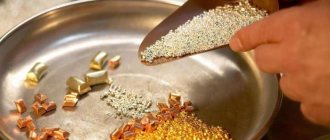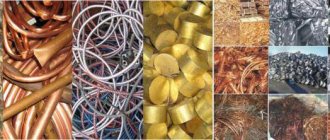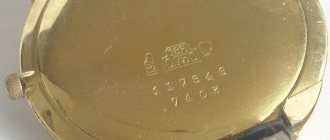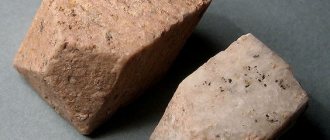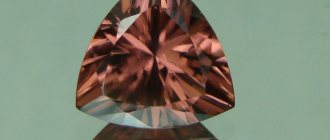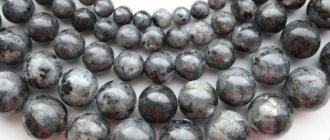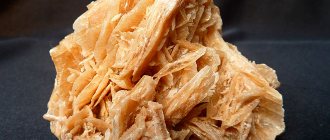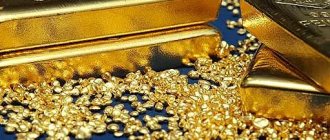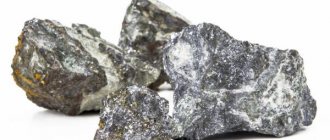Due to their high chemical inertness, they do not oxidize or corrode, thereby maintaining their characteristic shine and visual appeal.
Historically, precious metals have been used to make jewelry, and the high cost has placed gold and platinum in the same price range as precious stones.
In our age of high technology, precious metals are widely used in the production of products for the electronic, radio engineering and space industries, in the manufacture of laser technology and medical equipment, household appliances, computers and various gadgets.
Many parts included in hi-tech equipment contain precious metals in microscopic quantities.
Modern technologies for extracting this valuable material from secondary raw materials have turned the recycling of precious metals into a highly efficient production, surpassing in its profitability the extraction of gold, silver and platinum group elements from primary natural raw materials.
List of precious metals
The list of precious metals is presented in GOST R 52793-2007 “Precious metals. Terms and definitions" and legalized by the Federal Law of March 26, 1998. for No. 41-FZ “On Precious Metals and Precious Stones” (Article 1).
According to GOST R 52793-2007 (section 2), only 8 are considered precious metals, here is a list of them:
- gold;
- silver;
- platinum;
- palladium;
- iridium;
- rhodium;
- osmium;
- ruthenium.
As you can see, the list also includes silver, this will be interesting to know for those who are wondering whether silver is a precious metal.
Alloys in orthopedic dentistry
Metal occupies a central place among materials in dentistry. Most fixed dentures and removable denture frames are cast (or stamped) from dental alloys. Alloys in dentistry are used as auxiliary materials for soldering and stamping. Dental instruments are made from them.
Article outline:
- Classification of metals and alloys in dentistry
- Structural metal alloys in orthopedic dentistry
- Noble metal alloys in dentistry
- Base alloys in orthopedic dentistry
- Auxiliary metal alloys in dentistry
Areas of use
By nature, gold and other precious metals are endowed with unique consumer qualities , for which gold products or silver crafts are so dear to their owners.
It’s not for nothing that the term “precious” is interpreted in two ways in Russian dictionaries - both “valuable, expensive” and “dear, dear, very necessary.”
Nowadays, the first place among the special properties of precious metals, which are absent in other materials, is their high resistance to the destructive influences of the environment in which they are used.
Therefore, already from the middle of the 19th century, platinum, gold, silver, iridium and other noble elements became the subject of industrial use .
Each material has its own specific technological niche, in accordance with which its certain market value has been established, taking into account the need for it and the complexity of its extraction from natural raw materials.
Below is a summary of the use of precious metals and approximate prices in rubles/gram:
- Gold is used for the manufacture of jewelry and dental prostheses, as a solder or welding material in the manufacture of thermocouples, as an electroplating coating for circuit boards, contacts, and connectors in the manufacture of products for all industries. With the development of nanotechnology, telecommunications, aerospace and nuclear energy, the scope of gold has expanded significantly. Gold is present in targets for nuclear research, used in special casings for neutron bombs, etc. The price of gold is set at 2570.98 rubles/gram.
- Silver is used in contacts of electrical products, in copper-silver solders, in various alloys, and is still used in photography. A large amount of silver is used for the manufacture of high-energy density batteries (silver-zinc and silver-cadmium) and as additives to lead for current leads of lead-acid batteries. Silver-coated mirrors are superior in reflective qualities to their aluminum-coated counterparts. The price of silver is set at 30.41 rubles/gram.
- Platinum still competes with gold in the production of jewelry, is indispensable for the manufacture of heat-resistant chemical laboratory glassware, and is popular in metallurgy as an alloying additive. Electroplating, heating elements, resistance thermometers, relay contacts - platinum is present everywhere. The cost of platinum is set at 1,756.73 rubles/gram.
- Rhodium is used for finishing jewelry, in the manufacture of thermocouples and neutron detectors for nuclear technology. Its heat-resistant properties are used in dies for glass filaments and thermocouples, and chemical inertness is taken into account in the production technology of nitric acid. The cost of rhodium is 5406.96 rubles/gram.
- Palladium, osmium, iridium and ruthenium are successfully used as catalysts for various technological processes in the chemical industry, in the manufacture of measuring sensors, for applying special coatings in products of the defense and space industries, and in telecommunication systems. Platinum group metals are indispensable for the manufacture of technological equipment operated in aggressive environments. Corrosion-resistant, heat-resistant alloys of ruthenium with iridium and platinum are materials for dies for fiberglass and viscose. Executive-class fountain pens are very popular, in which the writing “eternal” nibs, in accordance with their name, are soldered with osmium alloys with palladium and platinum.
For platinoids, as the noble elements of the platinum group are often called, the Central Bank of the Russian Federation has set the following prices:
- palladium – 2220.49 rubles/gram;
- osmium – 854.86 rubles/gram;
- iridium – 3120.22 rubles/gram;
- ruthenium – 559.93 rubles/gram.
You can read more about prices, as well as about methods of donating precious metals, be it metal refined from radio components or scrap jewelry, here.
Natural mining and production
The share of precious metals in the production volume of the global mining industry is only 0.00005%. The content of noble elements in the earth's crust is small; accordingly, the volumes of their extraction are not comparable with the development of other minerals. For example, less than 30 tons of rhodium are mined annually .
However, taking into account the high prices of gold, platinum and other precious metals, the cost of mined precious metals exceeds 5% of the value expression of the volume of production of all minerals.
That is, it is reasonable to estimate the cost of mining precious metals in a proportion that is 100 thousand times higher than the cost of mining any other natural raw material (except diamond).
The extraction of gold and other precious metals plays a special role in the state development system, since the available reserves of precious metals determine the strategic state of the gold and foreign exchange reserves of any country.
With the development of technologies for extracting precious metals from various types of raw materials in industrialized countries, three areas of production have emerged, each of which contributes to the replenishment of state gold and foreign exchange reserves:
- Primary mining associated with the extraction of precious metals from ore and the production of concentrated (enriched) materials, as well as the processing of industrial waste.
- Associated production associated with the extraction of precious metals from polymetallic ores mined for the production of non-ferrous metals.
- Recycling, which is the recovery of primarily gold, silver and platinum from scrap precious metals and waste.
In the Russian Federation, gold production indicators for 2014 were as follows :
- primary production – 232185 kg;
- associated production – 16880 kg;
- secondary production – 38913 kg.
Let's show similar indicators for silver for 2014:
- primary production – 510272 kg;
- associated production – 287978 kg;
- secondary production – 249139 kg.
There are several articles on the topic of independent mining of precious metals on our website:
- Search magnets for gold and silver.
- Metal detector for gold and silver mining.
- How to look for gold with a metal detector.
- We make a metal detector with our own hands.
Osmium-187 – $10,000 per gram
Why does a chemical have such a high selling price? There are simple explanations for this: firstly, there is a very small amount of this isotope in nature. Secondly, the enormous complexity of isotope separation. Until recently, it was possible to obtain osmium-187 only by mass separation using unique centrifuges, using only one technology - separating isotopes of radioactive elements. Mass centrifuges rotate around the clock. The procedure for obtaining osmium-187 lasts about 9 months. Osmium is a finely crystalline black powder with a purple tint. Being the densest substance on Earth.
Designations of precious metals
To designate chemical elements, natural substances and materials of artificial origin, special symbols are used in the form of conventional signs (symbols), codes or abbreviations that provide brief and visual information about the name of a chemical element or similar simple substance.
For noble metals
the following designations are accepted :
- gold - Au (from Latin Aurum);
- silver – Ag (from Latin Argentum);
- platinum – Pt (from Latin Platinum);
- palladium – Pd (from Latin Palladium);
- rhodium – Rh (from Latin Rhodium);
- ruthenium - Ru (from Latin Ruthenium);
- osmium - Os (from Latin Osmium);
- iridium - Ir (from Latin Iridium).
The symbolism of the symbols of precious metals is used for the following purposes :
- when marking jewelry;
- in metallurgy - in labeling information about the chemical composition of non-ferrous metal alloys in which precious metals are present as alloying additives (ligatures);
- when using precious metals as currency values, exchange commodities or other purposes in the financial market;
- when designating coin metals used in numismatics.
When designating precious metals in alloys, Cyrillic letters are used . For example, according to GOST 13498-2010 “Platinum and alloys based on it. Marks" the following designations of precious metals are accepted (clause 3.1):
- Pl – platinum;
- Pd – palladium;
- I – iridium;
- Rd – rhodium;
- Ru – ruthenium.
In particular, the PlRd 93-7 alloy contains platinum and rhodium.
Similarly for gold and silver in GOST 30649-99 “Alloys based on precious metals for jewelry. Brands" the corresponding designations Zl and Sr are adopted (clause 3.1).
For example, the ZlSrPd 585-255-160 alloy contains gold, silver and palladium.
Cobalt chromium alloy in dentistry
(cobalt-chromium alloy, cobalt-chromium alloy)
COMPOUND:
- cobalt 66-67%, alloy base, hard, durable and light metal.
- chromium 26-30%, introduced mainly (as in steel) to increase corrosion resistance.
- nickel 3-5%, increases ductility, malleability, toughness of the alloy, improves the technological properties of the alloy.
- molybdenum 4-5.5%, increases the strength of the alloy.
- manganese 0.5%, which increases strength and casting quality, lowers the melting point, and helps remove toxic sulfur compounds from the alloy.
- carbon 0.2%, reduces the melting point and improves the fluidity of the alloy.
- silicon 0.5%, improves the quality of castings, increases the fluidity of the alloy.
- iron 0.5%, increases fluidity, improves casting quality.
PROPERTIES of KHS dental alloy:
It is distinguished by good physical and mechanical properties, low density (and, accordingly, the weight of restorations) and excellent fluidity, allowing the casting of openwork products of high strength.
Melting point is 1458 C
The alloy is resistant to abrasion and retains a mirror-like shine for a long time.
Cobalt-chrome alloy in dentistry
Used for cast crowns, bridges, solid clasp dentures, frames of metal-ceramic dentures, removable dentures with cast bases, splinting devices, cast clasps.
Metal-ceramics metal composition in dentistry
Cellite-K – cobalt-chromium
metal alloy
metal ceramics in dentistry.
Product marking
In the production of technical products for various purposes and jewelry, precious metals are used exclusively in the form of alloys with other metals.
Precious metal alloys get their name from their main component (gold alloys, platinum alloys, etc.).
The main materials used for jewelry are gold, silver, platinum and palladium.
Other platinoids (rhodium, osmium, iridium and ruthenium) are added to precious metal alloys in order to adjust the physical and technical properties of the product being manufactured - color changes, ductility and hardness, heat resistance and melting point.
To identify products containing precious metals, markings are used (from German markieren - to put a mark, an iconic mark) with marking information applied in the following ways :
- using a mark (branding) directly on the surface of the product - for jewelry;
- entries in product passports, forms, labels, operating manuals, reference books and catalogs.
Purpose and methods of branding
According to the “Regulations on hallmarking and hallmarking of products made of precious metals...” (Decree of the President of the Russian Federation dated October 2, 1992 No. 1152), all jewelry and household products made from precious metals for sale must be branded with the state hallmark (clause 2 ).
The mark is applied only when the jewelry is made in accordance with all official canons and meets state quality standards.
The absence of a mark clearly indicates that it has not passed the inspection of the state inspection service, or was simply not presented to it and is being sold in circumvention of legal regulations.
Another marking on the product is the name tag, which is an imprint designating the manufacturer who manufactured the product.
The sale of jewelry made of precious metals without a name mark and inspection by the assay service is illegal .
At its core, hallmarking is an assay-technological operation of applying an hallmark to products made of precious metals. The method of its application is determined by the degree of complexity of the shape and purpose of the product on which the marking must be applied.
Currently, three branding methods are used:
- A mechanical or impact method of applying a mark, based on mechanical action on the surface of the jewelry (hitting a tool with a mark on the tip with a hammer after applying the mark to the surface of the product). Until now, about 80% of all products made from precious metals are branded in this way. Only the hammer has been replaced by automated stamping machines.
- Electroerosive or electro-spark method, which is essentially the burning of a mark with an electric spark. This branding technique is convenient for working with fragile hollow products. About 10-20% of all jewelry products are branded using the electrospark method.
- Laser method, in which the outline of the mark is applied with a laser. This mark is small in size, but has clear outlines. It is considered the only way to brand convex and concave hollow products.
How to read the mark?
The mark consists of two marks , which are either applied separately or presented together on one print:
- images of the sample mark;
- identification design - a five-pointed star with a hammer and sickle (for products produced before 1994) or a female head in a kokoshnik with a profile turned to the right for products of a later release, as shown in the table below.
The presence of an identification mark indicates that it has been assayed and stamped by the Assay Supervision Inspectorate.
The shape of the mark depends on the type of noble alloy. Below are sketches of hallmarks:
- pos. 1 – for gold items (in the form of a kind of spatula);
- pos. 2 – for silver alloys (barrel-shaped);
- pos. 3 – for products made of platinum (in the form of a polyhedron);
- pos. 4 – for products made of palladium (truncated cone with a semicircular base).
The contents of the hallmark indicate the following information (for example, the image of the hallmark of a 750-karat gold product is used and is indicated in red letters):
- pos. A – code of the supervision inspection;
- pos. B – identification mark;
- pos. B – test sign.
What is a sample?
Fineness is the quantitative content of pure precious metal in a jewelry alloy. The sample indicator is the mass of the noble metal expressed in grams , which is contained in 1 kg of the alloy.
The sample is assigned to any jewelry alloy.
For jewelry and household products made of precious metals in the Russian Federation in accordance with the Decree of the Government of the Russian Federation of June 18, 1999. The following samples were accepted for No. 643:
- for gold – 375, 500, 585, 750, 958 and 999;
- for silver – 800, 830, 875, 925, 960 and 999;
- for platinum – 850, 900 and 950;
- for palladium – 500 and 850.
Assay marks on jewelry are usually placed in the following places :
- for rings, use the inner side of the rim;
- for pendants, use the outer side of the ear;
- lock details are used on earrings, brooches and chains.
Nickel-chromium alloys in dentistry
Alloys in which the main element is Ni. The elements of this alloy, in addition to nickel, are Cr (at least 20%), Co and molybdenum (Mo) (4%).
The properties of the nickel alloy are close to the cobalt alloy.
Used: for casting fixed dentures and removable denture frames.
Today, the use of nickel alloys is limited due to their high allergenicity.
Titanium alloys in orthopedic dentistry
In dentistry, both pure titanium (99.5%) and its alloys are used.
Pure titanium
Alloys of titanium, aluminum and vanadium (90-6-4%, respectively) are used for casting and milling. And an alloy of titanium with aluminum and niobium (87-6-7%).
Titanium alloys are lightweight and surprisingly strong. But they are refractory and difficult to process.
In orthodontics, alloys of titanium, vanadium and aluminum (75-15-10%) are used to make arches.
Metals used in orthopedic dentistry
Nickel and titanium alloy – titanium nickelide – nickel 55%, titanium 45%.
The alloy has shape memory. Deformed cooled products made from this alloy return to their original shape when heated.
The alloy is used in orthodontics, where it takes the desired shape under the influence of body temperature.
It is also used to make endodontic instruments with shape memory.
Current state of primary production
Gold mining occupies a priority position in the mining industry of any country.
A distinctive feature of modern primary mining of precious metals is the depletion of almost all known deposits .
For gold mining, industrial processing of ore from a primary deposit is recognized as profitable when extracting gold in the range of 1-5 g per ton of rock, and for placer mines the content of 0.1-0.5 g of gold grains per ton of processed sand is already welcomed and is considered beneficial for development.
quite large undeveloped gold deposits in Russia .
Against the backdrop of problems associated with the practical implementation of technologies for primary mining and processing of millions of tons of rock for the sake of just a few kilograms of gold or platinum, methods for processing metal-containing secondary raw materials are gaining popularity.
Scrap of precious metals and waste from the production of products containing noble metals are hundreds and thousands of times higher than natural sources in terms of the content of noble components in them. You can read about the cost of scrap precious metals in this article.
In many industrialized countries, recycling technologies return precious metals in quantities of up to 40% of the total volume of gold and other precious metals produced.
Despite the obvious stagnation of primary gold production, the level of its production, like other precious metals, is growing year after year. This is due to an increase in the volume of secondary production of precious metals.
Low-melting alloys in orthopedic dentistry
Low-melting alloys (Mellota, Wood, Rose) - contain Bismuth, Tin, Lead
– their melting point is about 70 C.
They are used for dies when stamping crowns, counter dies, and making collapsible models.
Low-melting metals in dentistry
Wood's alloy.
Melting point 68 C.
Composition: Bismuth – 50%, Lead – 25%, Tin – 12.5%, Cadmium – 12.5%.
Toxic because it contains cadmium.
Mellot alloy.
Melting point 63 C
Composition: Bismuth – 50%, Lead – 20%, Tin – 30%.
Rose alloy for dentistry.
Melting point 94 C.
Composition: Bismuth – 50%, Lead and Tin 25% each.
Sources of secondary raw materials
Sources of precious secondary raw materials can be:
- failed parts of industrial equipment, measuring equipment and control automation;
- waste from the production of radio electronics, television equipment, chemical industry, metallurgy, printing and other industrial sectors;
- jewelry production waste;
- scrap of precious metals.
Scrap of precious metals, considered as secondary raw materials, is represented by the following main groups of used products :
- For gold and silver scrap, the sources are used jewelry, thermocouples and temperature sensors, parts of household refrigerators, televisions, elements of office equipment (computers and printers), radio components, gadgets, telecommunications equipment, catalysts and catalytic grids, batteries, etc.
- For platinum group metal scrap, sources include jewelry made from various alloys of platinum and palladium, catalytic meshes and thermocouples, electrolysis equipment, laboratory glassware, crucibles and lids for them, other laboratory supplies, cases of glass melting equipment, dies, fragments of products coated with precious metals .
Auxiliary alloys used in orthopedic dentistry
Bronze is an alloy of copper and tin. Aluminum bronze (aluminum instead of tin) is used in dentistry. It is used to make ligatures for splinting jaw fractures.
Brass is an alloy of copper and zinc; pins for collapsible models are made from it.
Magnalium is an alloy of aluminum and magnesium; aircraft parts are made from it (the alloy is very light and durable). In dentistry, articulators and some cuvettes are made from it.
Amalgams are an alloy of metal and mercury. Used for filling.
The topic is too broad; amalgam in dentistry will be discussed in a separate article.
Content of precious metals in secondary raw materials
By its chemical composition, secondary raw materials of precious metals are complex multicomponent metallurgical raw materials.
As a rule, in addition to precious metals, scrap and waste contain alloys of iron, aluminum and copper, glass, glass ceramics, fiberglass, and polymers.
The content of precious metals in various objects and devices can only be determined after they have been processed in a refining organization capable of purifying gold, platinum, palladium and other metals to the highest standard.
The status of refining organizations is assigned to enterprises that carry out industrial purification (French affinage - purification, purification) of impurities of precious metals and bringing their quality to the requirements of the relevant standards.
to assess the quantitative content of gold, silver or other noble element in the “secondary” material prepared for processing on the basis of reference data that is available for each product or group of identical parts, or by a hallmark stamp on a piece of scrap jewelry.
For example, for a transistor of the KT 203 B series, the reference book indicates that it contains 0.0076 g of gold as gold plating on the terminals.
We offer you several articles on the topic of the content of precious metals in various products and their refining:
- Content of precious metals in radio components.
- Gold content in radio components.
- Contents in cars.
- Precious metals in household and office equipment.
- Refining of radio components.
- Refining of various items.
- Gold refining.
Where can I buy or sell?
The main lots on the market remain platinum and gold. If you represent a company or have an individual entrepreneur, it is more profitable to buy metals from officially registered brokerage companies that work with leading manufacturing plants.
Expert opinion
Lyudmila Pestereva
Our most experienced gold investor
Ask a Question
It is easier for an individual to cooperate with banks that offer a wide range of services for the purchase of precious metals. For example, buy bullion and put them in your own cell, open a deposit and even make money on your investments.
Which precious metal is the most expensive?
If we are talking about the most popular and popular metals, then the leading place in the price ranking is occupied by palladium, platinum and gold.
However, Californian is rightfully considered the most expensive metal on earth.
It is mined during the operation of powerful nuclear reactors. The price for 1 gram of Californian is 6.5 million dollars. Next on the list of expensive metals is rhodium. It is estimated at 225 thousand dollars per gram.
Positive aspects of recycling
The main positive aspects of using the so-called “secondary” precious metals are the following circumstances :
- Unlike natural mineral raw materials used for primary mining and extraction of precious metals, secondary raw materials, represented by scrap gold, silver or platinum group metals, are much richer in the content of precious metals.
- Due to the increasing growth in the consumption of computer equipment, radio and television equipment, various gadgets, office equipment and household electrical appliances, the number of those that fail or are rejected during production or warranty service, which inherently serve as an endless source of precious metals in the form of recyclable materials, is correspondingly increasing. At the same time, the painful issue of recycling monitors, televisions, computers and other products that are subject to disposal in specialized organizations is being resolved.
- Precious metals recycling technologies do not require large production areas and have fewer technological stages compared to primary mining.
The gold content in secondary raw materials, depending on the type of scrap, can range from 1% to 50% by weight; for silver the figure is somewhat more modest - from 0.1% to 15%. This means that 100-200 kg or more of the precious metal can be extracted from 1 ton of gold scrap.
Steel for dental instruments
Tool steel – contains carbon from 0.7% or more.
It is characterized by high strength and hardness (after special temperature treatment).
The addition of tungsten, molybdenum, vanadium and chromium to steel makes the steel capable of cutting well at high speeds. This steel is used for burs and cutters.
Tungsten carbide is not an alloy. A chemical compound of tungsten with carbon (chemical formula WC). Comparable in hardness to diamond. Used for the production of armor-piercing tank shells. And also for carbide dental burs.
Zirconium metal in dentistry
Zirconium dioxide is also not an alloy. Chemical compound of zirconium metal with oxygen. Its chemical nature is similar to ceramics, but it is harder and more durable. In dentistry they are used for the manufacture of milled dentures.

